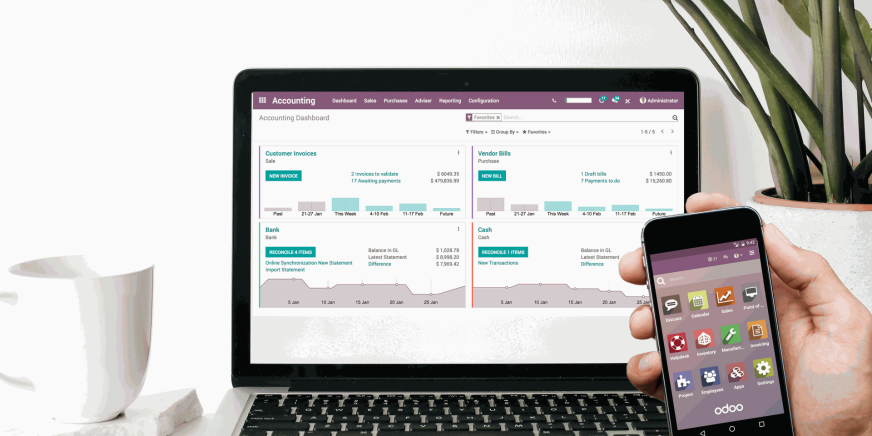Andrew Telfer on Wedoo’s remarkable growth in the ERP market
Wedoo’s business accelerated when the ERP consultancy switched to open-source system Odoo, and to SiteHost Dedicated Servers.

Five years ago, the ERP implementation experts at Wedoo switched from an old Windows system to open-source Odoo. We spoke with Andrew Telfer, Director, about the rapid growth that’s followed, and how SiteHost Dedicated Servers let hundreds of concurrent users manage and run businesses around New Zealand and Australia.
Hi Andrew, tell us about Wedoo.
Andrew Telfer: Wedoo is an Odoo reseller. Odoo is an ERP (enterprise resource planning) system that comes out of Belgium. I think it has around 11 million users worldwide, and Wedoo is the largest Odoo implementer in New Zealand.
Today we specialise in customising Odoo and fine-tuning it for our clients. Before Odoo we were a Sage reseller, which meant we were largely working in a Windows and Microsoft world. In 20 or 30 years of operation we got up to around 200 Sage clients. After picking up Odoo about five years ago we have around 80 Odoo sites, so we've grown fast.
Where do your new clients come from?
Most of our leads find us, basically, which is a good place to be. We get a lot of people who have attempted to implement it themselves before they come to us. We also get people calling out of the blue saying they've heard of Odoo and that they're interested in implementing it.
As a result, we don't really do any sales or marketing.
What sort of clients do you work with?
We work across a pretty broad spectrum - our clients range from small businesses of five people up to companies that have 300-plus users. They include the likes of Trade Tested, Medifab and Pharmaco.
Our services are ongoing. We provide continued support for our customers, including many that we've had for over 20 years using Sage and then Odoo.
What led you to choose Odoo? What other options does it compete against?
Odoo's very flexible. Out of the box it's a very broad application in terms of functionality.
Typically the usual suspects that we compete against are things like Dynamics 365 Business Central or NetSuite. Most vendors are pretty well represented in New Zealand's ERP market. The owner of Odoo is a guy called Fabian Pinckaers, and his mission in life is to take on SAP as a tier one application.
That’s definitely ambitious. How does Odoo’s functionality measure up?
It comes in two flavours. The community version is free, and the enterprise version has more features but is paid for. It covers an entire business from financials and accounting right through to inventory, distribution, and warehouse management. It also has a lot of other functionality such as project management, CRM, email marketing and so on—quite an extensive list. So it really is an ERP, in that the scope of the application goes across the entire business.
It's not like other systems where you'll have pieces of software here, here and here and you link them all together. It is a single solution for a business.
How about usability?
Odoo's getting a pretty good reputation in the market. The system is very easy to use. It’s comparable to Xero in terms of ease of use, and in fact we have a lot of people using Xero who convert to Odoo. But Odoo is significantly more complex than Xero in terms of how it works.
How complex is implementation?
From a technical implementation perspective, it is a very complex system. Typically I’d say it's a six-month implementation, minimum. We could do smaller sites in three months. Some implementations go for a year or even longer.
With those timelines, how are you managing to grow your capacity alongside your customer base?
We've grown very, very fast with Odoo - almost 30% growth year-on-year. That's been a wee bit painful to deal with. Our total staff has jumped from the low 20s to well over 30, heading towards 40, in a couple of years. We've done a significant number of implementations and had a bit of a crunch in terms of project resource constraints. It's been a challenge over the last couple of years but we're shaping up pretty well now.
What are you focusing on with your team now?
The challenge that we're working on is to improve the execution of implementations. We've got a lot of experience but, like any business, none of our systems are perfect and we're constantly trying to improve them.
How much of a learning curve was there for your business to move from reselling Sage to offering Odoo instead?
It was a significant shift after being Microsoft-orientated for so long; a big move to a Linux world and open source technologies. It took us a wee while and we had real challenges around DevOps, around UAT environments, and around standing everything up to work nice and cleanly.
It took quite a long time to get right and we're still working on it.
From your viewpoint today, how do you see the change?
Like night and day. We had a lot of success with Sage over almost 30 years but the product that we were dealing with, Sage 300 or ACCPAC as it was previously called, was fairly old. We had gotten very good at customising it, but it was never designed to be customised. We were feeding in our APIs and it was all just patchwork on the outside.
How does Odoo compare in that sense?
The change was very significant. Odoo’s completely different because it was built from the ground up to be customised. So we’re like kids in a candy store with all this additional capability in the core system. We can customise any part of it.
Have you migrated clients from Sage to Odoo?
Yes, quite a few. When Sage clients move to Odoo, it’s a full implementation that we treat like we were moving from any other system.
How does your capacity to handle large implementations compare to others in New Zealand?
In New Zealand there are four, maybe five companies that do Odoo. Only two have the really serious capability to deploy to a client of any size. We're the largest and there's one other who are very experienced and capable.
I don’t really think of us as competitors. At the end of the day we're all just trying to wave the Odoo flag in New Zealand and communicate out how good a product it is.
Wedoo also has a bit of an international footprint, don’t you?
When we had the Sage business, we had sites that we supported all over the world in South Africa and North America. Now with Odoo we have a few clients in Australia. It’s growing, and these sites are significant, over 100 users each.
One of them was an existing Sage site that we've converted. Another large one that we're currently implementing was a result of a conversation at an Odoo conference.
The third one was a company that was already running a very old version of Odoo and not getting very good support from their partner in Australia. They reached out and they've been with us for over a year now. We moved their infrastructure onto SiteHost and we're about to upgrade them to the latest version of Odoo.
That leads to the really interesting stuff: Tell us about Odoo hosting.
There are multiple options for deploying it. Odoo's SaaS offering is very much an out-of-the-box solution with no customisation and limited apps that you can deploy to it. The level above that is Odoo.sh which supports customisation and any app that you want. Those two approaches are fairly simple to stand up, but Odoo.sh still has quite a high degree of complexity around customising the application. It involves technologies, like Git, which most people aren’t really familiar with, let alone doing Python-specific development for Odoo.
Odoo have quite a lot of scalability in their hosting platform. Last year they demoed an Odoo system running 10,000 concurrent users on their platform. That added some weight to their plans to take on SAP! Obviously there’s some pretty serious hardware backing that up.
The third option is deploying Odoo on premise. That can be in a private cloud or on your own servers, and this is where it gets more complicated. Odoo supports Windows and Ubuntu, however we don't deploy via Windows. Its natural environment is Linux and it's easier to make it work there.
Do you have a preference out of all those options?
From our perspective, what matters is that the service is fit for purpose. We have clients on Odoo.sh, clients in a private cloud that we deliver through SiteHost, and clients who have engaged their own suppliers.
What led you to team up with us at SiteHost?
Historically, when we operated in a Windows world, we owned our own servers. When we moved from Sage to Odoo it was a fundamental technology shift. We went from Windows, Microsoft SQL, and applications that were built in Visual Basic and .NET to a world which is largely Ubuntu, Python, with Postgres and a whole bunch of other things. Basically an entirely different stack. That's when we looked for a hosting partner to help us out.
What separated SiteHost from the others?
When we selected SiteHost it came down to bang for buck. You know your pricing’s good, and the bare metal servers that you offer include fast disk, lots of memory, and good processors.
We have the technical capability to leverage all that capacity. So if a client’s going to have, say, 30 concurrent Odoo users then one of your 128GB servers with 3.7TB on NvME disk is just perfect.
We've had no performance issues at all. Also, Quintin's great to deal with and you guys have been amazing. The machines just run smoothly and we haven’t really had any issues. We needed to restore a client site about 6 months ago, and you guys bent over backwards to give us a hand with that. It was awesome.
That was why we selected SiteHost.
Can you tell us a bit more about how you’re using those Dedicated Servers?
All these machines run Ubuntu native, with virtualisation over the top of that using KVM (Kernel-based Virtual Machine). Some sites use Docker, depending on the setup. They just run really, really well. For some clients we run test and production systems on a single server.
These servers have been awesome for us. We'll just continue adding on as we grow.
When you talk about the load from concurrent users, is it usually consistent throughout a work day or is it more important to deal with peaks?
Odoo’s scope is end-to-end within the business, so people are logged into it all day. Our servers need to be able to accommodate the load consistently.
Take the Australian client that we moved onto SiteHost when we upgraded Odoo. They're on a server with half a terabyte of RAM and a significant amount of disk. We have KVM running on it and that server accommodates not only their existing production system, but also their upgrading and UAT environments as well. Really that single server is driving the whole business, plus the implementation of the upgrade. And it’s handling it easily.
As well as getting the infrastructure right, how much of that performance is down to Odoo’s efficiency?
It's natively quite a fast application and not resource hungry. One of the good things about Odoo is it's very efficient. It’s built to scale to large organisations, with that goal of knocking SAP off the tier one pedestal. There’s a wee way to go but they're moving towards that for sure.
It sounds like you’re well-placed to be part of the ERP revolution! Thanks for your time today.


